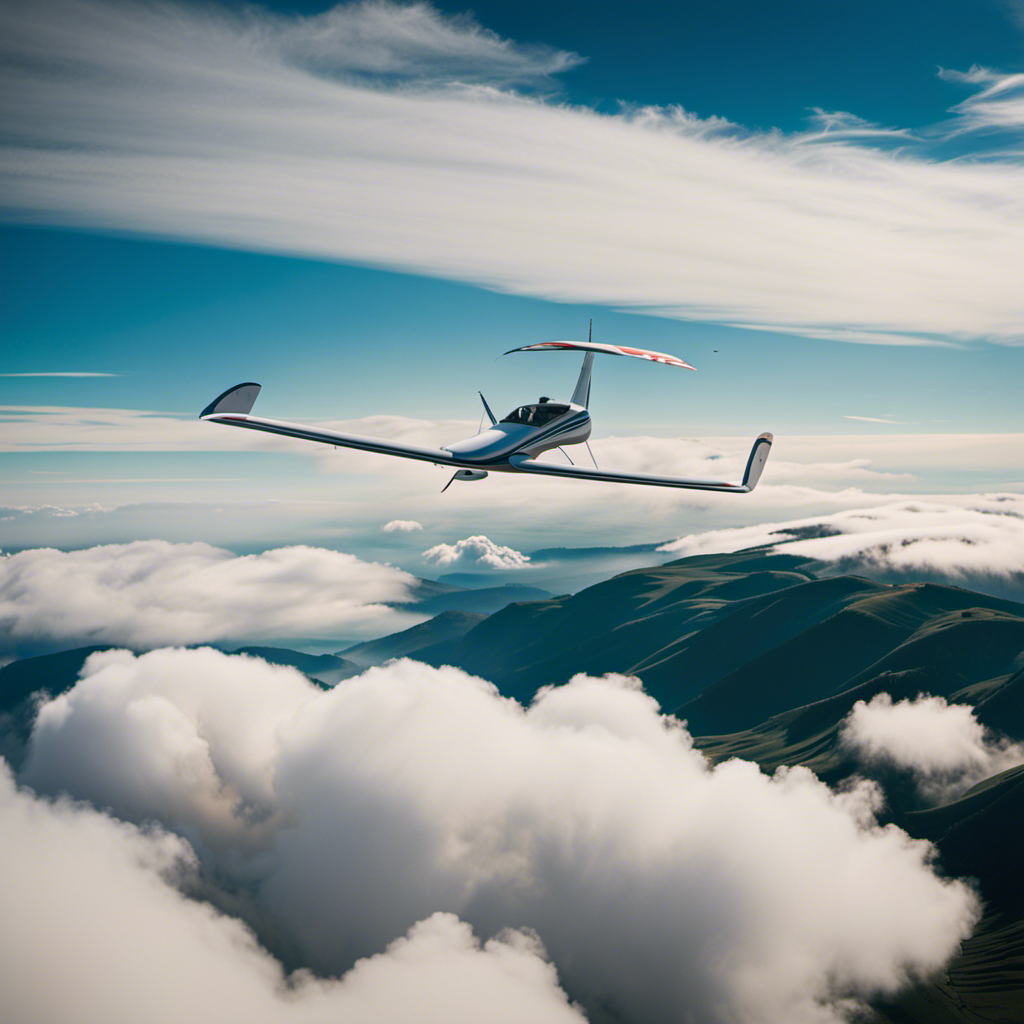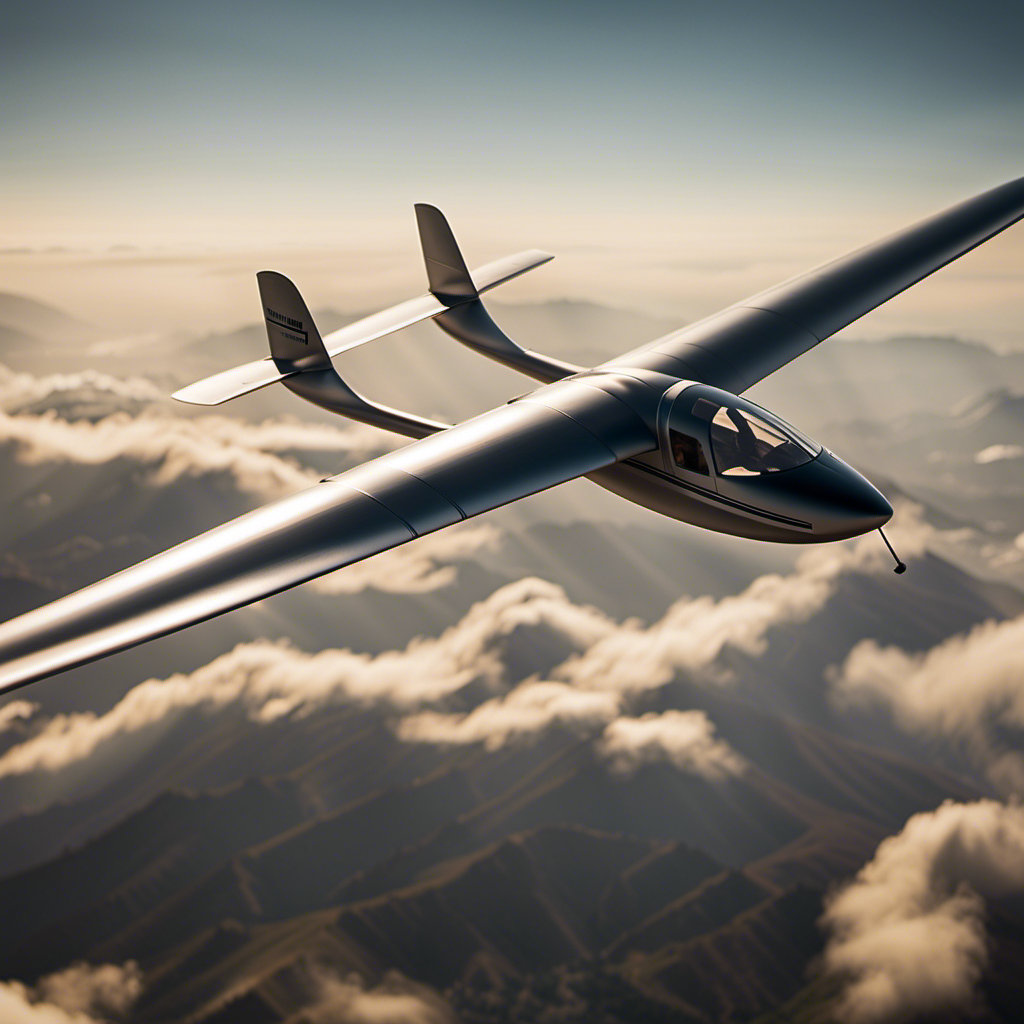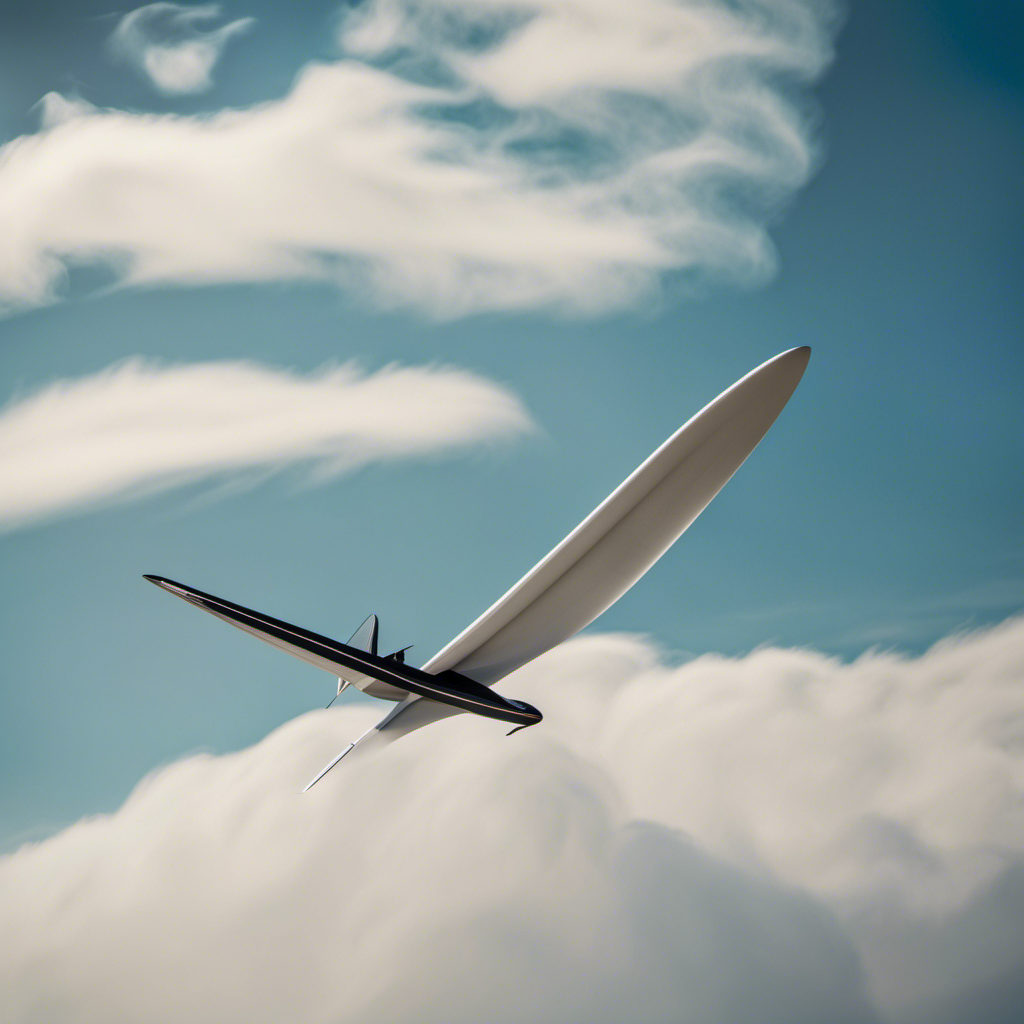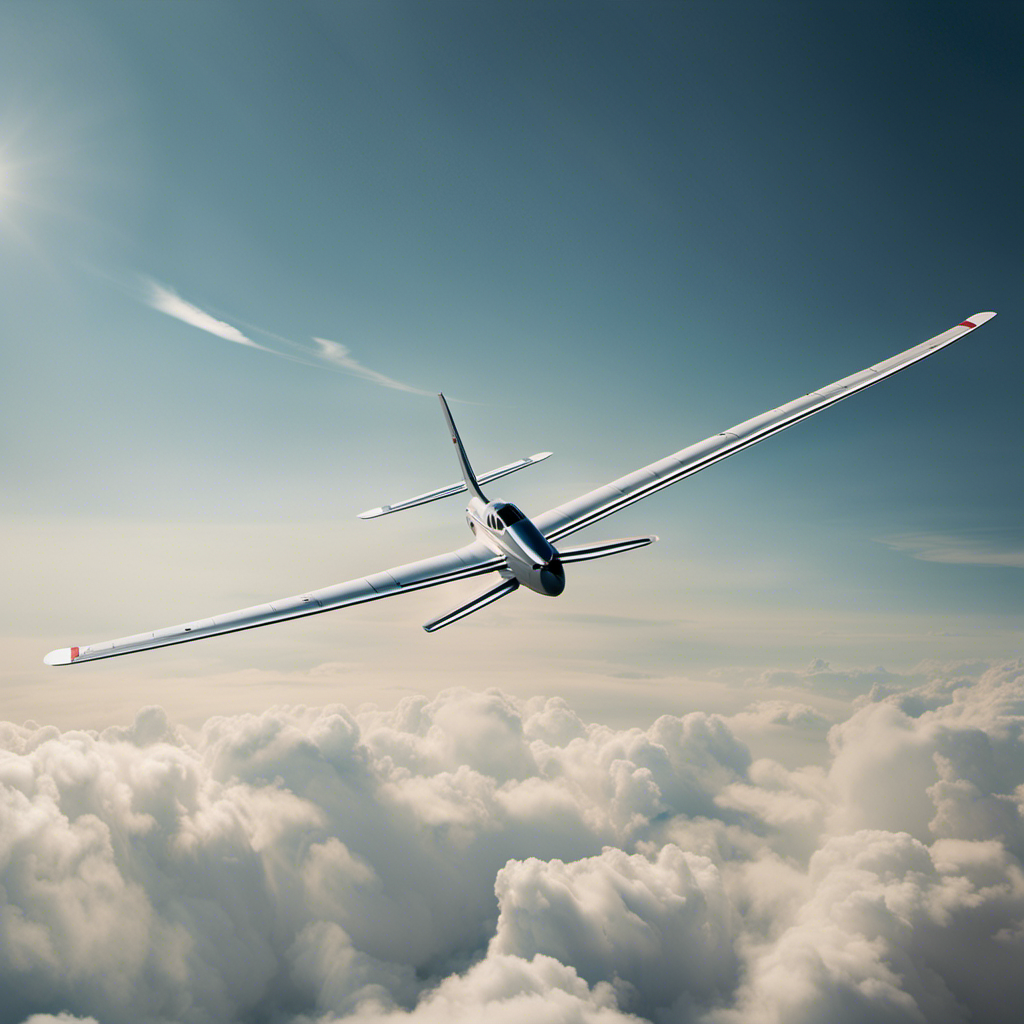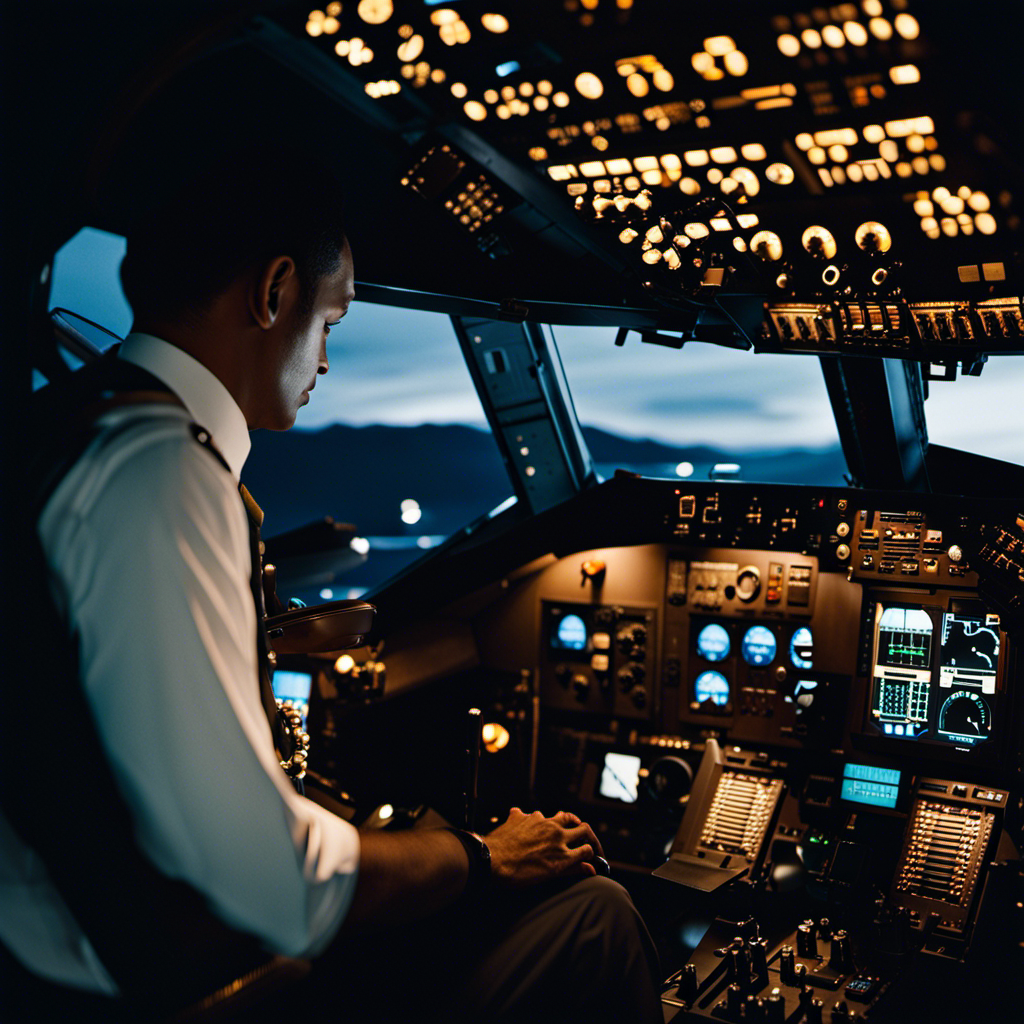Do you have a dream of soaring through the skies? If so, you’re in luck! I’m here to help you achieve your glider certification.
In this step-by-step guide, I’ll walk you through the requirements, finding a reputable flight school, completing the necessary training, passing the exam, and submitting the required documentation.
With dedication and a love for aviation, you’ll soon be on your way to receiving your glider pilot certificate. Let’s get started!
Key Takeaways
- Review the official guidelines for qualifications and prerequisites, including minimum age limit and flight hours/experience required.
- Research reputable glider flight schools and consider the qualifications and experience of instructors.
- Enroll in a comprehensive ground school course to deepen understanding of glider flight principles and develop a safety mindset.
- Complete the required flight hours and learn basic flight maneuvers, including takeoffs, landings, and advanced maneuvers like stalls and spins.
Understand the Requirements and Eligibility Criteria
To understand the requirements and eligibility criteria for glider certification, you’ll need to review the official guidelines provided by the aviation authority. These guidelines outline the specific qualifications and prerequisites that you must meet in order to obtain your glider certification.
The requirements typically include a minimum age limit, which is usually around 16 years old, and a minimum number of flight hours or experience in gliding. Additionally, you may need to pass a written exam as well as a practical flight test to demonstrate your knowledge and proficiency in gliding.
In terms of qualifications, it is important to note that glider certification is open to individuals of all backgrounds and experience levels. Whether you are a complete beginner or an experienced pilot looking to expand your skills, there are pathways available for you to obtain your glider certification. However, it is recommended that you have a basic understanding of aviation principles and a strong commitment to safety.
Once you have familiarized yourself with the requirements and qualifications for glider certification, the next step is to find a reputable glider flight school. This will provide you with the necessary training and instruction to meet the certification standards and prepare you for the written exam and flight test.
Find a Reputable Glider Flight School
Finding a reputable glider flight school can be a crucial first step in earning your certification. Choosing the right glider flight school is essential to ensure that you receive the proper training and guidance to become a skilled glider pilot. When evaluating training options, there are a few key factors to consider.
Firstly, it is important to research the reputation of the glider flight school. Look for schools that have a strong track record of producing successful glider pilots and have been in operation for a significant period of time. Additionally, consider the qualifications and experience of the instructors at the school. Experienced instructors who are knowledgeable in glider flight techniques and safety protocols can greatly enhance your learning experience.
Furthermore, evaluate the training options offered by the school. Some flight schools may offer different programs tailored to individual needs and goals. Look for schools that offer a comprehensive curriculum, including both theoretical and practical training. It is also beneficial to inquire about the availability of simulators or other training aids that can supplement your learning.
In conclusion, choosing the right glider flight school is a crucial decision in your journey towards glider certification. By carefully evaluating training options and considering factors such as reputation and curriculum, you can ensure that you receive the best possible education and preparation for your glider pilot certification.
Transitioning into the subsequent section, enrolling in a ground school course will further expand your knowledge and understanding of glider flight principles.
Enroll in a Ground School Course
Enroll in a ground school course to deepen your understanding of glider flight principles. Ground school provides a solid foundation of knowledge that is essential for safe and successful glider flying. Here are three key benefits of enrolling in a ground school course:
-
Comprehensive Curriculum: Ground school courses cover a wide range of topics related to glider flight, including aerodynamics, meteorology, navigation, regulations, and emergency procedures. The curriculum is designed to ensure that you have a thorough understanding of the principles and concepts that govern glider flying.
-
Practical Application: Ground school courses not only teach you the theory behind glider flight, but also provide practical application exercises. You will learn how to interpret weather forecasts, plan flights, calculate performance parameters, and analyze flight situations. This hands-on approach allows you to apply the knowledge you gain in real-world scenarios.
-
Safety Focus: Safety is a top priority in ground school courses. You will learn about potential hazards and how to mitigate risks during glider flights. You will also be trained on emergency procedures and how to handle unexpected situations. By enrolling in ground school, you will develop a safety mindset that will guide you throughout your glider flying career.
Completing a ground school course is an important step towards obtaining your glider certification. It provides you with the knowledge and skills necessary to safely navigate the skies as a glider pilot.
Now, let’s move on to the next section and explore how to complete the required flight hours.
Complete the Required Flight Hours
As a glider pilot, it’s crucial to learn and master basic flight maneuvers to ensure safe and efficient flying. Understanding concepts such as pitch, roll, and yaw will allow for precise control of the aircraft.
Additionally, practicing takeoffs and landings is essential to develop the necessary skills for a smooth and controlled approach to the runway.
Learn Basic Flight Maneuvers
Learning basic flight maneuvers is essential for obtaining glider certification. These maneuvers are crucial for flight safety and allow pilots to have full control over the aircraft in various situations. Mastering these maneuvers will not only enhance your flying skills but also build confidence in handling the glider.
In addition to the fundamental maneuvers such as straight and level flight, turns, and climbs, it is important to learn advanced maneuvers like stalls and spins. These maneuvers teach you how to recover from potentially dangerous situations and improve your overall understanding of the glider’s aerodynamics.
Once you have a solid foundation in basic flight maneuvers, you can move on to practicing takeoffs and landings, which are critical skills for safe and successful glider operations.
Practice Takeoffs and Landings
To improve your skills in takeoffs and landings, it’s important to practice regularly and focus on maintaining proper speed and control throughout the entire process.
These critical maneuvers require precision and technique to ensure a safe and smooth flight.
When practicing takeoffs, it’s crucial to smoothly increase power, allowing the glider to accelerate to the appropriate speed. Maintaining a proper pitch attitude and controlling the glider’s climb rate during the initial climb-out is essential.
During landings, it’s important to establish and maintain a suitable approach speed, ensuring that the glider remains stable and under control. Anticipating and adjusting for wind conditions, while using proper landing techniques, will further enhance safety.
By regularly practicing takeoffs and landings, you will become more proficient and confident in these maneuvers, ultimately improving your overall flying skills.
As you continue to hone your abilities, it’s important to also prepare for the written exam.
Pass the Written Exam
You’ll need to study and prepare for the written exam in order to pass. The written exam is a crucial part of obtaining glider certification, as it tests your theoretical knowledge and understanding of aviation principles.
To ensure success, here are some important aspects to consider during your written exam preparation:
-
Obtain study materials: Acquire the necessary study materials, such as textbooks, online resources, and practice exams. These materials will provide you with the essential information and help familiarize you with the exam format.
-
Focus on key topics: Identify the key topics that are likely to be covered in the exam. These may include aerodynamics, meteorology, navigation, regulations, and aircraft systems. Allocate sufficient time to study each topic thoroughly.
-
Create a study schedule: Develop a study schedule that allows you to allocate dedicated time for exam preparation. Set achievable goals for each study session and establish a structured routine to ensure consistent progress.
-
Take practice exams: Utilize practice exams to simulate the actual exam environment and assess your readiness. Identify areas of weakness and focus on improving your knowledge in those specific areas.
-
Seek guidance and clarification: If you encounter difficulties during your study, don’t hesitate to seek guidance from experienced pilots or instructors. They can provide valuable insights and clarification on complex topics.
Once you have successfully passed the written exam, the next step is to schedule and pass the practical flight test, where you will demonstrate your skills and proficiency in handling a glider.
Schedule and Pass the Practical Flight Test
Once you’ve passed the written exam, the next step is scheduling and passing the practical flight test to demonstrate your skills and proficiency. This is a crucial part of the glider certification process as it allows the examiner to evaluate your ability to handle the aircraft in various flight scenarios. Flight test preparation is key to ensuring a successful outcome.
To prepare for the flight test, it is important to review the practical test standards provided by the Federal Aviation Administration (FAA). These standards outline the maneuvers and tasks that you will be evaluated on during the test. Familiarize yourself with these requirements and practice them extensively before the actual test.
In addition to studying the practical test standards, it is also beneficial to fly with an experienced instructor who can simulate the test conditions and provide feedback on your performance. This will help you identify areas that need improvement and allow you to refine your skills accordingly.
On the day of the flight test, arrive well-rested and mentally prepared. Ensure that all required equipment and documentation are in order. During the test, listen carefully to the examiner’s instructions and ask for clarification if needed. Execute each maneuver with precision and confidence, paying attention to the details outlined in the practical test standards.
Obtain and Submit the Required Documentation
After passing the practical flight test, it’s crucial to gather and submit the necessary documentation for your glider certification. Obtaining the necessary documents is an important step in the certification process and requires careful attention to detail.
Here is a timeline for the certification process and the required documentation:
-
Medical Certificate: You will need to provide a valid medical certificate to ensure that you are physically fit to operate a glider.
-
Proof of Training: Submit your logbook or training records to demonstrate that you have completed the required training hours and flights.
-
Written Exam Results: Include the results of your written exam, which tests your knowledge of glider operations, regulations, and safety procedures.
-
Flight Test Report: Attach the flight test report, signed by an authorized flight examiner, documenting your performance during the practical flight test.
-
Application Form: Fill out the glider certification application form accurately and completely.
Pay the Certification Fees
When it comes to obtaining glider certification, it’s crucial to understand the cost associated with the process.
This includes not only the initial certification fees but also any additional charges for training materials or exams.
Once you have a clear understanding of the cost, it’s important to make proper payment arrangements in order to proceed with the certification process smoothly.
Understand the Cost of Certification
Understanding the cost of certification is crucial before pursuing glider certification. As an aspiring glider pilot, it is essential to have a clear understanding of the financial commitment involved in the certification process. The cost of glider certification can vary depending on factors such as the location, the flight school, and the type of certification desired.
It is important to research and compare different flight schools to find the one that offers the best value for your investment. Additionally, finding financial assistance options can help alleviate some of the financial burden. Many flight schools offer scholarships, grants, or financing options that can make the certification more affordable.
Make Payment Arrangements
Once you’ve researched and compared different flight schools, you can start making payment arrangements for your glider certification. It’s important to consider the payment options and financial assistance available to you. Many flight schools offer flexible payment plans to accommodate your budget. Some schools may require a down payment upfront, followed by installment payments over the course of your training. Others may offer financing options or scholarships for those who qualify. To help you visualize the different payment options, here’s a table outlining some common choices:
| Payment Option | Description |
|---|---|
| Upfront Payment | Paying the full cost of certification upfront. |
| Installment Payments | Breaking down the payment into smaller installments. |
| Financing | Taking out a loan to cover the certification costs. |
| Scholarships | Financial aid awarded to eligible applicants. |
| Work-Study Program | Earning money towards certification through work. |
Receive Your Glider Pilot Certificate
To receive your glider pilot certificate, you’ll need to complete a practical flight test. Before undertaking this test, it is essential to find a qualified flight instructor who can guide and train you adequately. A good flight instructor will have the knowledge and experience to teach you the necessary skills and techniques required for glider flying. They will also help you prepare for the oral exam, which is an important part of the certification process.
During the oral exam, the examiner will assess your knowledge and understanding of glider flying principles, regulations, and procedures. It is crucial to thoroughly study the glider pilot handbook and other relevant materials to ensure you are well-prepared. Your flight instructor can provide guidance on the areas to focus on and help you practice answering potential questions.
Once you have completed your practical flight test and passed the oral exam, you will be awarded your glider pilot certificate. However, the journey does not end here. As a glider pilot, it is important to continue learning and improving your skills. This will involve gaining more flight experience, participating in advanced training courses, and staying up-to-date with the latest developments in glider flying. By constantly striving to enhance your abilities, you will become a more proficient and confident glider pilot.
Continue to Learn and Improve Your Skills
As a glider pilot, it’s important to keep learning and improving your skills to become more proficient and confident. One way to do this is by constantly seeking new techniques to improve your flying abilities. Whether it’s through reading books, attending workshops, or watching instructional videos, there are numerous resources available to help you refine your skills. Additionally, seeking mentorship from experienced glider pilots can be invaluable. Having someone guide you and provide feedback on your technique can greatly accelerate your progress.
To emphasize the importance of continuous learning and seeking mentorship, here is a table showcasing the benefits of these practices:
| Improving Techniques | Seeking Mentorship |
|---|---|
| Enhances safety | Provides guidance |
| Increases efficiency | Boosts confidence |
| Improves decision making | Shares valuable experiences |
| Enhances situational awareness | Offers constructive feedback |
| Expands knowledge base | Fosters personal growth |
Frequently Asked Questions
Are there any age limits or restrictions for obtaining a glider pilot certificate?
There are age limits and restrictions for obtaining a glider pilot certificate. These include passing a practical flight test, accumulating flight hours, obtaining a medical certificate, meeting physical requirements, and possibly undergoing fitness tests.
Can I use my own glider for the practical flight test?
Yes, you can use your own glider for the practical flight test. However, it must meet the training requirements and be approved by the certifying authority to ensure safety and compliance with regulations.
Is there a time limit for completing the required flight hours?
There is no time limit for completing the required flight hours for glider certification. However, it is important to note that the practical flight test requirements must be met before obtaining the certification. So, take your time and ensure you fulfill all the necessary requirements.
Do I need a medical certificate to obtain a glider pilot certificate?
Yes, a medical certificate is required to obtain a glider pilot certificate. There are certain age limits for the certificate, which may vary depending on the country or aviation authority.
Are there any specific physical requirements or fitness tests for glider certification?
Physical limitations and fitness requirements are essential for glider certification. It’s important to note that gliding has a low accident rate, with only 1.3 accidents per 100,000 hours flown, making it a relatively safe activity.
Conclusion
In conclusion, obtaining glider certification is an exhilarating journey filled with challenges and triumphs. It requires dedication, commitment, and a thirst for knowledge.
By following the step-by-step guide outlined above, you can embark on this exciting adventure with confidence. Remember, the sky is your playground, and with your glider pilot certificate in hand, you can soar to new heights.
So, spread your wings and embrace the thrill of gliding as you continue to expand your skills and become a master of the skies.
